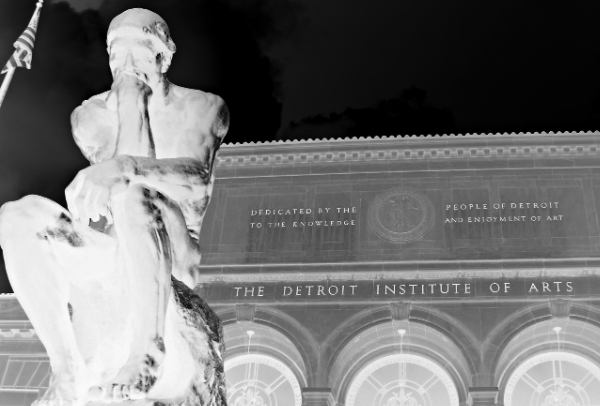The desperation is getting palpable

While Governor Rick Snyder met with billionaire Warren Buffett and Goldman Sachs CEO Lloyd Blankfein in Detroit yesterday, another group of wealthy moneymen were across town filing a motion with the federal judge asking that he take action on their behalf in Detroit’s ongoing bankruptcy saga. The banks that are owed money by Detroit are getting increasingly fearful that they may not walk away from their decades of investments without taking a loss. After refusing to tour the city to see the devastation that they helped enable, they now want the city to pay for a team to appraise the art collection of the Detroit Institute of Arts to “maximize the value of the art to enhance creditor recoveries”. This is despite the fact that the city has already paid Christie’s auction house out of New York to do the same thing.
They were blunt:
An executive at New York-based bond insurer Financial Guaranty Insurance Co., which led the drafting of the filing, told the Free Press in an exclusive interview that the city must sell art to satisfy creditors.“We recognize that this is a very sensitive issue,” said Derek Donnelly, managing director of FGIC. “Whatever process we undertake here, we would hope would create a win-win situation — that ultimately there will be a viable DIA that will survive this process and possibly even thrive. But at the same time there needs to be a construct that addresses the fact that the DIA, or art, is not an essential asset and especially not one that is essential to the delivery of services in the city.”
It’s so very nice of Mr. Donnelly to come to our state to tell which of Detroit’s assets is essential and which can be sold off to pay his bank. It’s a bit comical that he sees this as something that might be a “win” for the DIA, something that would help them “thrive”. He appears to believe that an art museum is like a blackberry bush that needs to be trimmed back in order to prosper.
At the end of the day, however, this has nothing to do about what’s best for Detroit or, more importantly, what’s best for the DIA. It’s about what’s best for the banks:
The creditors want the art evaluated, arguing it will help the city in crafting a debt-cutting plan that can be confirmed by the judge.The city’s plan needs to consider the best interests of creditors, according to the filing.
“Accordingly, the ‘best interests of creditors’ requirement dictates that the city must demonstrate that its plan maximizes the value of the art to enhance creditor recoveries,” lawyers wrote in Tuesday’s filing.
“The only way to prove this is to provide an assessment of the art based on arms-length market transactions, against which creditors and the court can compare the city’s … proposed treatment of the art (or any proceeds of a transaction that monetizes the art).”
“The best interests of” the banks that continued to loan money to an obviously failing city long after it was prudent. Why? Because all along, they thought it was a “sure thing” and that they would be paid back first. I’ve written about this before:
These creditors, mainly bankers who do not live in Detroit, have no interest in the visuals of wealthy mostly-white, mostly-men in front of the desperation that Orr wanted them to see. More importantly, they didn’t want to answer any questions about why they continued to pour millions upon millions of dollars into Detroit even as its downward spiral into financial crisis was obvious to everyone. Like a crack dealer selling drugs to users he knows will be dead in a year, they kept handing money to the city because they knew that debt was safe. If the city collapsed, they would be the first ones paid and they would be paid in full with everyone else left to fight over the remaining crumbs. It is, in fact, written into the Emergency Manager law itself:Section 11(1)(b) – The financial and operating plan shall provide for … The payment in full of the scheduled debt service requirements on all bonds, notes, and municipal securities of the local government, contract obligations in anticipation of which bonds, notes, and municipal securities are issued, and all other uncontested legal obligations.
In their minds (and on their spreadsheets), it was a sure bet. So they kept handing the city as much rope as it needed to get to the place they are today.
Now that Kevyn Orr has upset the apple cart and decided that it wasn’t a sure bet after all and that ALL of Detroit’s creditors will be treated equally, the banks are becoming desperate. They know their fate is largely in the hands of federal bankrutptcy judge Steven Rhodes who seems very much to have the best interests of the residents of Detroit, including its pensioners, in the front of his mind.
The gall of these banks to demand that Detroit foot the bill for yet another appraisal is astonishing. I hope Judge Rhodes tells them to go jump into the Detroit River and take their chutzpah with them.
Adding…As Amy Kerr Hardin points out at Democracy Tree, this pits our tea party Attorney General Bill Schuette against the banking creditors since he has come out strongly on the side of protecting the DIA’s collection from being looted to pay the banks. I wonder how long it will take the monied interests to convince him of the error in his ways. He is, after all, a Republican.
[DIA “Thinker” image modified from CC photo by Michael Barera | Wikimedia Commons]



